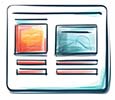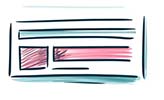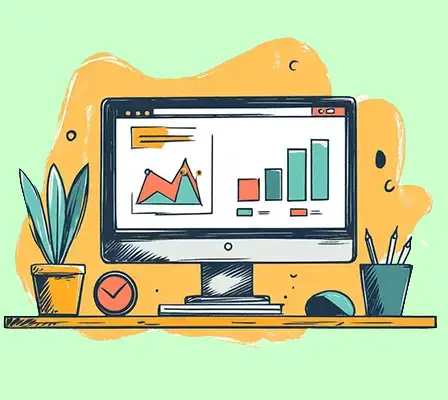When providing a website redesign service, the layout is one of the most important factors to get right. The way each page is structured has a direct impact on how users interact with your site.
What’s crucial to remember is that not every page needs the same layout - different pages serve different purposes.
By analysing your current website’s performance, we can identify which pages are working well and which need a rethink.
Let’s break down how we approach layouts for various key pages: the homepage, about page, services page, resource pages (such as blogs or articles), and the contact page.

Home page Layout
The homepage is the first impression most users will get, so its layout needs to be engaging and intuitive.
We typically structure it in rows. It might begin with a hero section, which is the large banner or image that grabs attention straight away.
This is followed by a brief introduction to your business.
Depending on your goals, the next row could focus on problems faced by your customers, followed by the solutions you provide.
This is where we address the pain points and show how your services can help.
Then, we move to a services section, benefits, and perhaps a three-step process to get started with your service or product.
Towards the end, we might include social proof such as testimonials, case studies, or logos of clients, followed by a call to action (CTA) to encourage users to engage further with your site.
The goal of the homepage layout is simple: guide the user to explore the internal pages that matter most to them, whether it’s a service page or your blog.

About page Layout
The about page is where you tell your story.
This page builds trust by showcasing who you are as a business and what you stand for.
Users visiting this page want to understand your expertise, experience, and values.
Again, we break the page into rows, starting with a brief overview of your company.
You’ll want to touch on your team and qualifications, but not in a way that feels overwhelming - just enough to reassure the user that you’ve got the skills and experience to solve their problem.
Make sure to keep it friendly but professional. Think of it as the handshake at the start of a business meeting: it’s all about building confidence and trust.

Services page Layout
Your service pages are your shop window, so they need to be sales-driven.
These pages need to balance information and persuasion.
Start with a headline that captures attention, followed by an introductory paragraph outlining the specific service you offer.
We can then break the page down into sections like features and benefits, a comparison against competitors, and client testimonials.
It's also a good idea to add a section for FAQs to cater to methodical and humanistic users who like more detail.
These pages will also include a strong call to action like "Request a Quote", "Get in Touch", or "Request a Call Back".
Remember, these pages need to convert visitors into leads, so they’re structured with the goal of taking users from interest to action.

Resource Pages (Blogs and Articles)
Resource pages such as blogs or articles are essential for building SEO authority and adding value to your users.
Each post should support your service pages by linking back to them.
This creates a pillar-cluster structure where your service pages act as pillar pages, and the related blogs or articles are cluster content.
This strategy helps search engines see the relevance of your content, driving better rankings for your main services.
These posts should be well-structured, with clear headlines, subheadings, and optimised for search engines.
We’ll ensure that every post is categorised properly and features an internal linking strategy to enhance user experience and SEO.

Contact Page Layout
The contact page is often overlooked, but its layout is just as important as the others.
It should be simple, with clear contact details, a location map if relevant, and a contact form for users to get in touch easily.
We don’t want to overcomplicate this page - just provide the essentials.
You can also add a thank you page that users see after they’ve submitted a form.
This not only confirms their message was received but also presents an opportunity for further engagement.

Summarising page layouts for website redesigns
The layout of each page on your website plays a critical role in its overall performance.
By tailoring the structure of each page to its specific purpose, we can ensure that users are drawn in and engaged with your content.
Whether it's guiding them through your homepage or making it easy for them to contact you, a well-thought-out layout is key to driving conversions and ensuring long-term success.
Every page layout is built with both users and search engines in mind, ensuring a balance between functionality and SEO.
At Webstudio, we focus on getting your layout right to not only improve user experience but also maximise your website’s performance.

Author
Technical Director
With over 20 years of experience in building and promoting websites, Neil is a seasoned expert in digital marketing and SEO. Passionate about helping businesses grow through innovative web solutions, Neil has successfully built over 400 websites.

